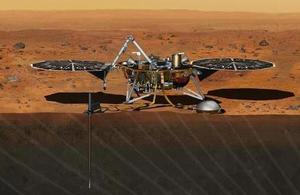The sound of Mars
A UK instrument has captured the first sounds ever recorded directly from Mars.

Artist's impression of InSight. Credit: NASA.
The NASA InSight lander, which is supported by the UK Space Agency, has recorded a haunting, low rumble caused by vibrations from the wind. These vibrations were detected by an ultra-sensitive seismometer, developed in the UK, and an air pressure sensor sitting on the lander’s deck.
Both recorded the Martian wind in different ways. The seismometer recorded vibrations as the wind moved over the lander’s solar panels, each of which is more than 2 metres in diameter and sticks out from the sides of the lander like a giant pair of ears. The air pressure sensor recorded the vibrations directly from changes in the air.
Science Minister Chris Skidmore said:
Less than two weeks into the InSight Mission, UK science is already uncovering incredible things about Mars. As new Science Minister I am excited to see what more we can achieve on land and in outer space.
The mission is an example of our successful space sector making a difference to international science. Through the Government’s Industrial Strategy, we are driving the biggest increase in public investment in research and development in UK history.
This is the only time during the mission that the seismometer - called the Seismic Experiment for Interior Structure, or SEIS - is capable of detecting these sounds. In a few weeks, it is due to be placed on the Martian surface by InSight’s robotic arm. For now, it is recording wind data that scientists will later be able to cancel out of data from the surface, allowing them to separate “noise” from actual Marsquakes.
Sue Horne, Head of Space Exploration at the UK Space Agency, said:
This is brilliant news because it means we know the sensors have survived the rigours of landing on Mars and are meeting the requirements to achieve their science goals. It is just amazing to hear the first ever sounds from Mars.
SEIS includes three Short Period sensors (SEIS SP) developed in partnership by Imperial College London, Oxford University and STFC RAL Space, with £4 million in funding from the UK Space Agency. These sensors can detect motion at sub-atomic scales, which includes the wind on Mars, which is barely within the lower range of human hearing.
When the sensors pick up vibrations from InSight’s solar panels, the whole spacecraft acts like a giant microphone.
InSight science team member Prof Tom Pike of Imperial College London said:
The solar panels on the lander’s sides are perfect acoustic receivers. It’s like InSight is cupping its ears.
Prof Pike compares the effect to a flag in the wind. As a flag breaks up the wind, it creates oscillations in frequency that the human ear perceives as flapping.
InSight, which landed on 26 November 2018, will study the inside of Mars to learn how planets, moons and meteorites with rocky surfaces, including the Earth and its Moon, formed.
Dr Neil Bowles, from the University of Oxford’s Department of Physics, said:
To get the first data from the seismometer instrument package has been fantastic and even with a short test run the analysis is now full swing.
To ‘hear’ the low frequency rumble of the Martian wind on the lander being picked up by the SEIS-SP is really eerie and provides a strangely human connection to this very different environment.
Both audio samples have been released to the public almost completely unaltered. In some cases, they have been raised an octave in order to be perceptible to the human ear.
But an even clearer sound from Mars is to come. In just a couple years, the British-built Mars 2020 rover is scheduled to land with two actual microphones on board. One has been included specifically to record the sound of a Martian landing for the first time. A second will be able to detect the sound of the instrument’s laser as it zaps different materials. This will help identify these materials based on the change in sound frequency.